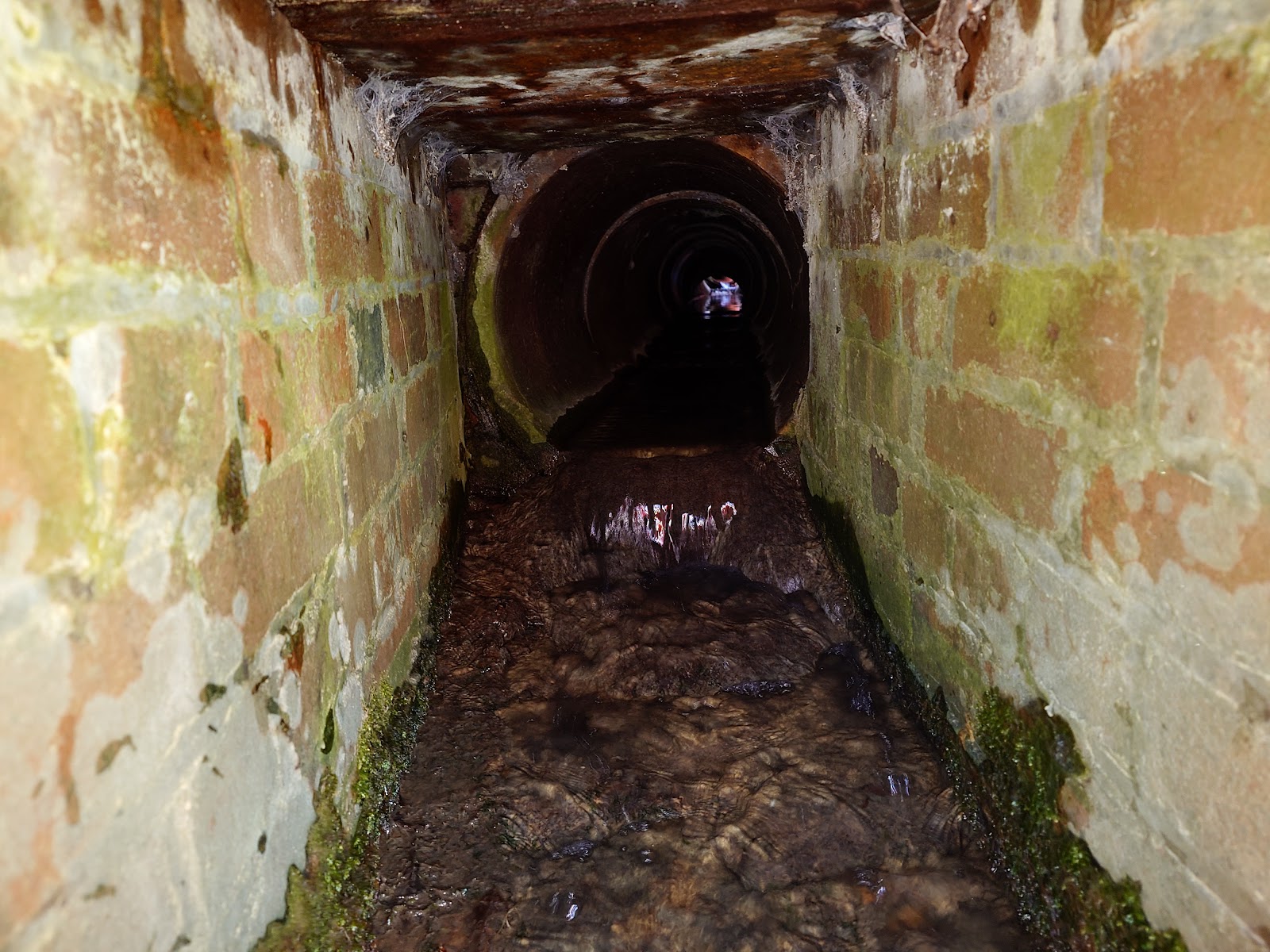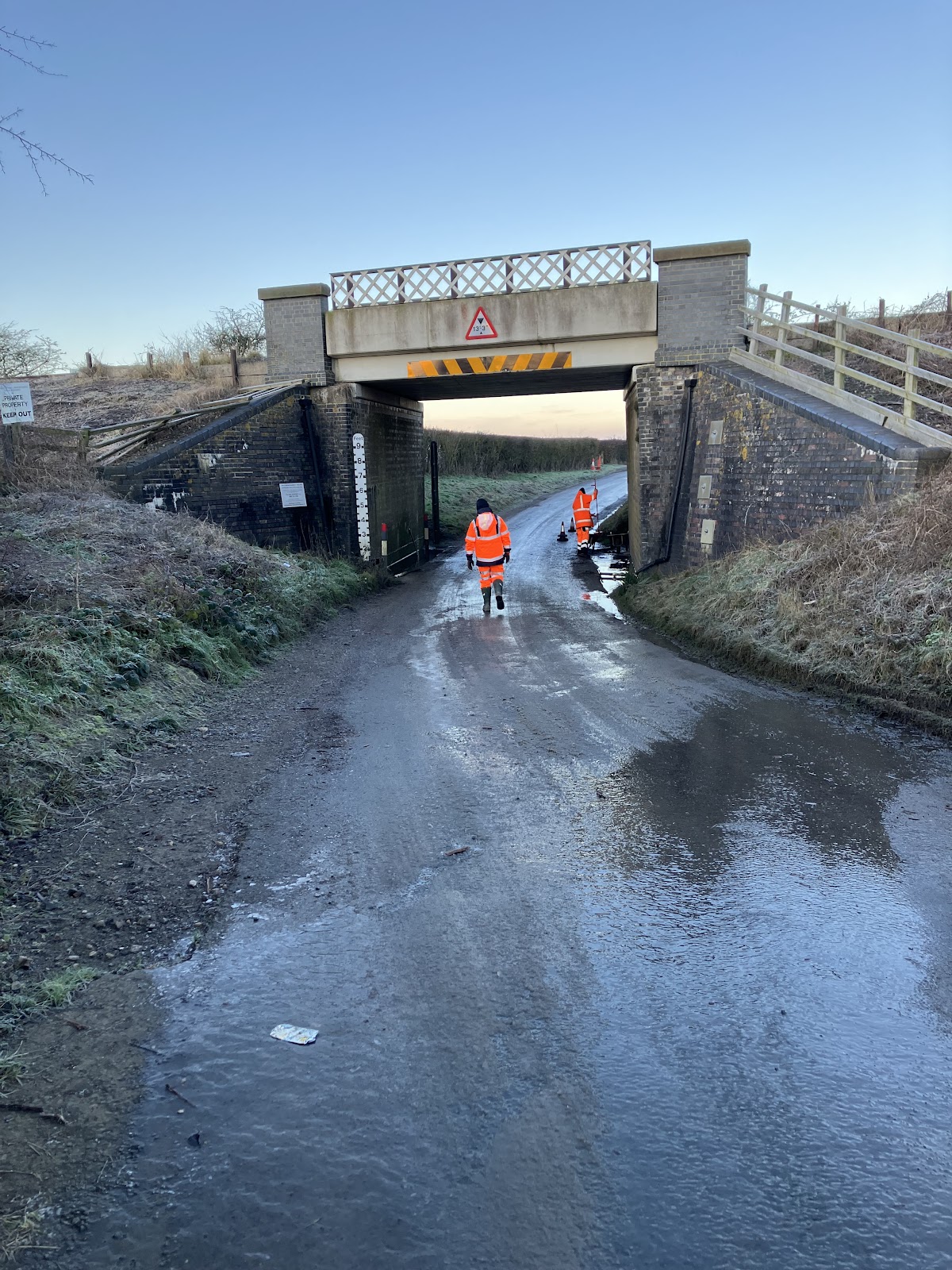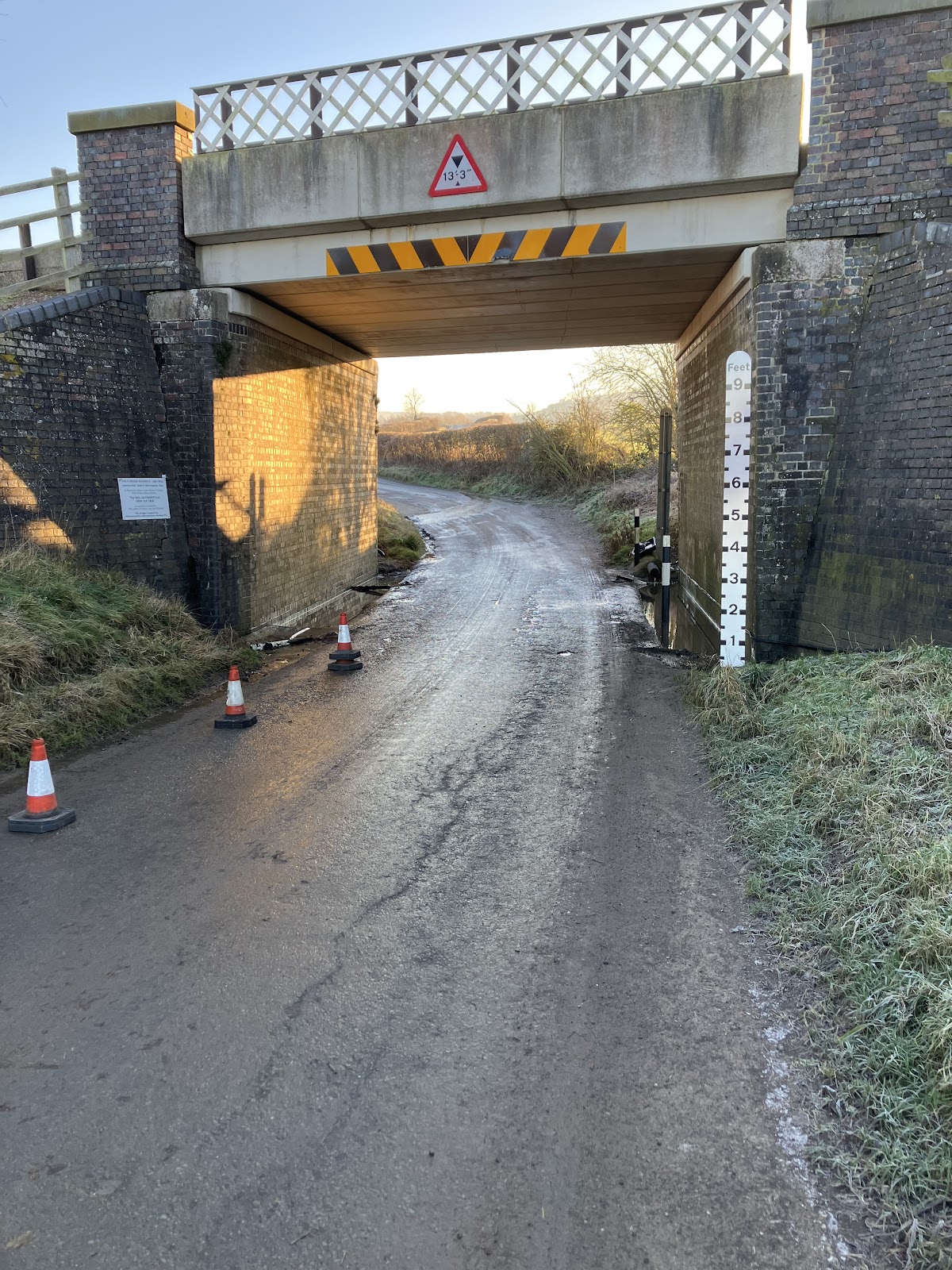The title of this post neatly sums up
the achievements of the team on (so far) the coldest day of the
winter.
Thursday 9th January
Eight of the team braved the cold
weather. Minus 5C was the lowest temperature reported on the journeys
to Winchcome, at Sedgebarrow. The maximum day time temperature was
not much above 3C, but at least it was sunny.
First the inspections. John, Polly and
Andrew headed to Cheltenham, south of the station to undertake the
annual visual inspections and clearance of culvert 45A at Wymans
Brook and 44A just south of Hunting Butts tunnel. More evidence of
the autumn and winter storms at the later, with fallen trees and
branches lying on both the inlet and outlet headwalls. Removing these
will be a task for a bigger group with saws. Fortunately there were sufficient
gaps in the branches to see the headwalls, and nothing in the stream
impeding the flow. Then it was back to Gotherington, to complete the
inspection of culvert 33B at the yard by the Skew Bridge. In our
haste to finish at lunchtime last week, we had overlooked checking the
small chamber where the low mileage down side cess is piped to the
culvert inlet. How we forgot that is a mystery; it was one we rebuilt
early last year. Then the final inspection; cross drain 25B at
Gretton. Unusually this claimed the accolade of the last item
inspected this season as it required low water levels. The outlet
from this briefly enters the adjoining field on the up side; the
landowner has recently excavated his section of ditch; so the water
level was back to normal.
 |
The down (Cotswold) side entry to culvert 45A, Wymans Brook, is a very deep manhole. This is just inside our boundary, on both north/south and east/west axis. The brook is piped from the lake in Pittville Park; the pipe then enters the original culvert bore to the right of this manhole.
|
 |
We are going to need more than a hedge trimmer to clear the fallen trees on the access to the down side of culvert 44A.
|
 |
On the west side of the road by Gotherington Skew bridge is an odd headwall constructed of fake Cotswold stone blocks. Maybe these were sourced from a garden centre many years ago.
|
 |
| The chamber we missed last week - 33B low mileage down side cess. |
 |
With the water level below the outlet pipe, we can now see what passes for a headwall at cross drain 25B.
|
Next the demolition. Jonathan and
Martin travelled to the top of the haul road opposite the Royal Oak
at Gretton. The task was the preparations for the rebuild of the
outlet of culvert 24A. First item was the removal of the temporary
parapet wall alongside the vacant up side track bed. Temporary in
this case was just under 5 years.
 |
Gone! The great (temporary) wall of Gretton above the outlet of culvert 24A. [Photo by Martin]
|
Next was clearing of vegetation to
create a working space for the required plant and materials. Useful
assistance for this came from the robo flail of Tom Clarke, as this
was on site to clear some of the vegetation towards Greet tunnel.
 |
Robo flail making short work of clearing a working space. [Photo by Jonathan]
|
Then some manual excavations in the outlet pond between the trackbed
and the haul road to confirm the exact location of the concrete base
for the new chamber. We had cast this back in 2019!
 |
Inside of the 24A extension (probably BR(W) era) with brick walls and now corroded steel plate roof. This we will replace with a pipe to the new chamber. [Photo by Jonathan]
|
 |
| The outlet pool of 24A between the trackbed and the haul road; this is where the new chamber will go. [Photo by Jonathan] |
|
 |
A very temporary safety barrier now above the 24A outlet. (Yes the modern red plastic items do have some useful deployments.) This will be very temporary; will be gone by the time Gold Cup race trains run. Note the Malvern Hills in the distance.
|
The road clearance team was Nigel,
Dave and Peter. Following the heavy rain and snow melt the previous
Monday; we suspected some flooding still to be present under some of the troublesome underbridges. The first location checked was bridge 6, Laverton
Meadow Lane. The flood had receded there; so it was just a case of
clearing the silt traps under the bridge and ensuring the roadside
gully grills were free of debris. Then a similar exercise at bridge
16, Didbrook No2. Same situation; apart from the fact this bridge
does not have hard silt traps at the roadside beneath it. At both
locations, we think the main cause of the flooding after heavy or
prolonged rain is that the exit pipes of the roadside gullies are too
small to handle the volume of water. Hence the deep puddles form and
take a few days to drain away.
 |
Bridge 6, Laverton Meadow Lane from the down (Cotswold) side before clearing. [Photo by Dave]
|
 |
And from the up (Malvern) side after cleaning. [Photo by Dave]
|
 |
Bridge 16, Didbrook No2, down side low mileage roadside gully cleared. Roadside verge here is soft. [Photo by Dave]
|
 |
The PWay team working on the Didbrook track relaying above bridge 17. [Photo by Dave]
|
All three groups then met at 24A
opposite the Royal Oak. Although midday and sunny; a cold wind had
now got up. So not a comfortable spot for lunch. Hence the decision
to return to Winchcombe and the warmth of Churchward House. But
before that, a couple of quick jobs. Peter tested his wellies
(waterproofing and warmth capabilities) by wading into the outlet
pool of culvert 24A with tape measure to measure the diameter of the
pipes under the trackbed and under the haul road. The new chamber
will fit between these. Finally three of the team attended to the
outlet ditch of culvert 24C at the foot of the haul road. Clearing
the grill at the boundary fence here is another one of our regular
winter tasks.
 |
Regular blog readers will recognise this - the outlet ditch of 24C (up side) at Working Lane. One day we will build a proper silt trap here - but even then that will still need regular cleaning out.
|
After warming up over lunch, the whole
team attended to some housekeeping tasks at Winchcombe. This included
moving a delivery of cement under cover. Also we combed our stock of
twinwall pipes to see if we had any that would be suitable for the
24A rebuild. Unfortunately not, hence we will have to order a new
section.
Wildlife report: Working in an
urban environment at Wymans Brook we noticed quite a lot more garden
birds. Identified were sparrows, yellow wagtails and wrens. Plus the
inevitable robins. Behind a large sheet of plywood propped up against
the wall of the shed in Winchcombe Yard we discovered a neat nest –
again this probably belongs to a robin.















Would the council responsible for drainage consider increasing the size of of the gullies as mentioned to reduce the chance of flooding?
ReplyDeleteGordon, Unfortunately sorting out drainage on some minor roads is probably way down the priority for GCC Highways. Both Didbrook No2 and Laverton Meadow lane have alternative roads when they are impassable. There are more pressing issues for the roads around the railway - such as the flooding caused by the cycleway between Bishops Cleeve and Gotherington.
Delete